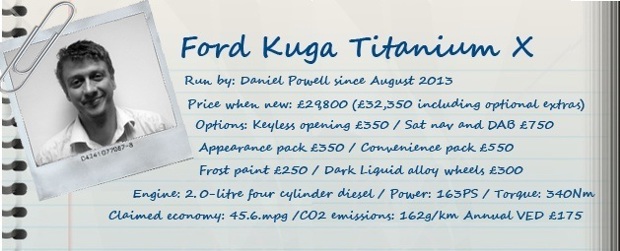Newest addition to the fleet – Ford Kuga
Now in its second generation, the Ford Kuga has plenty of crossover appeal, with an attractive design, cavernous interior and a silky smooth diesel engine.
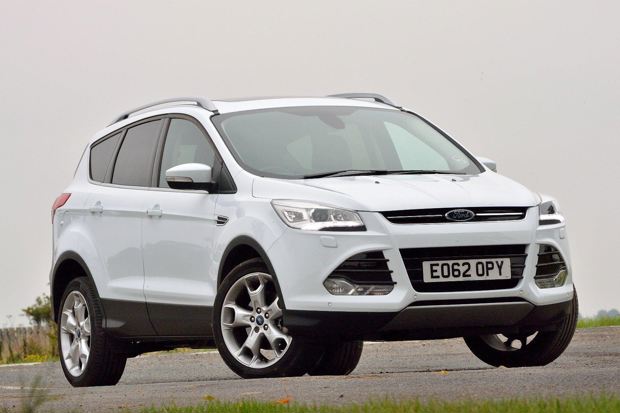
Date: 15 August 2013 | Current mileage: 284 | Claimed economy: 45.6mpg | Actual economy: 33.1mpg
The Kuga has come a long way since its first launch in 2008, with 100,000 sales proving that Ford can indeed cut it with the likes of Nissan and Volkswagen when it comes to building a capable SUV. Now, in its second generation, the Kuga is packing a serious punch in market with a stylish exterior and added refinement to its interior and handling.
I was a big fan of the first Kuga, but have to admit that this second generation looks a much more accomplished project. So, why have I decided to take one on long term loan? Well, first off, I need something that can eat up the motorway miles during the week, but also boast the versatility of four-wheel drive to cope with my rural jaunts to the country at the weekends.
According to Ford, the typical Kuga buyer opts for the higher spec model, so I’ve chosen to run the Titanium X. It’s not quite the range topper - that accolade goes to the Titanium X Sport - but it’s not far off and I’ve boosted its appeal with a selection of the most popular option packs, including keyless opening, active park assist, Sony DAB navigation and a rear view camera. Being a cynical old car journalist, I’ve always question the need for costly options on a new car and I’ll be giving an honest insight into these extras as I write about the Kuga in the coming months.
Under the bonnet, I’ve picked Ford’s tried and trusted 2.0-litre TDCI unit; it’s the same engine as found in the Focus, Mondeo and S-MAX, which means it shouldn’t give me any problems. I’ve opted for the more powerful 163PS version as I regularly shift heavy loads around and feel its 240Nm of torque will cope with everything I can throw at it. Ford claims the engine is frugal too, with a claimed 45.6mpg; however, as with the extra options, I’ll be checking this for myself and letting you know if the figures stack up in the face of everyday driving.

PowerShift automatic gearbox gives smooth and quick shifts
Other key features on the Kuga include permanent all-wheel drive and a six-speed automatic PowerShift gearbox, which is a common combination on this model. Being a Titanium X, it also feature an impressive amount of standard kit, including a LED running lights, hill start assist and panoramic glass roof.
First impressions of the Kuga have so far been good, with its roomy interior being a big improvement over the first generation model. The Titanium X gets leather trimmed seats as standard and, in the few journeys I’ve made, they’ve proven to be extremely comfortable. The dashboard is laid out in an intelligent fashion too, with everything being easy to read and understand. Unlike some SUV manufacturers, Ford places everything in chronological order, which means you instantly know which button to press. In fact, after just two trips, I knew all the primary features and how to use them.
Another big plus point on the second generation Kuga is its panoramic roof; it allows lots of natural daylight to enter the car and also has the added bonus of a sunroof – something I’ve not experienced since my old Ford Sierra Sapphire.
In the back there’s plenty of leg room and a big boot, with 406 litres of storage. Fold the rear seats down flat and that increases to a whopping 1603 litres, which is more than enough for my needs. Over the coming weeks and months I’ll be putting the Kuga to task and will be letting you know if it cuts the proverbial mustard. However, first impressions considered, it’s a case of so far so good…
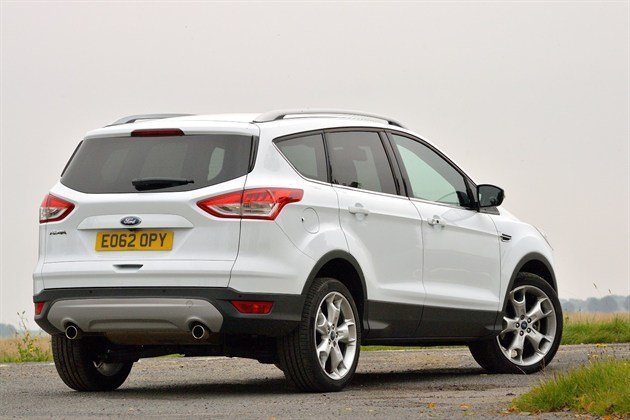
Kuga covers 800 miles in first week
It’s been a busy few weeks for the Kuga. I’ve covered 800 miles, which has been split between motorway runs and rural trips.
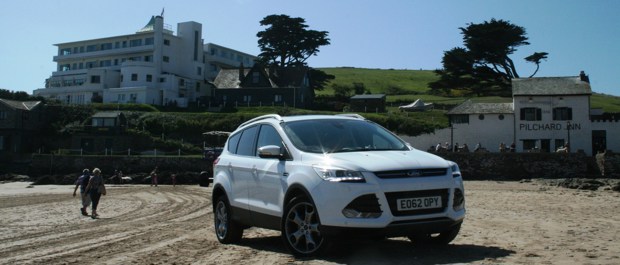
Date: 29 August 2013 | Current mileage: 1134 | Claimed economy: 45.6mpg | Actual economy: 36.9mpg
It’s been a busy few weeks for the Kuga as I’ve phased it into life as my daily runner. So far I’ve covered 800 miles, which has been equally split between motorway runs and rural trips.
The Kuga’s first big test was a week-long holiday trip to Devon; I felt the long run down the M25 and M4 would be a good starting point. I also believed that Devon’s B roads and sandy beach tracks would be an ideal test for the Kuga’s rural mettle.
On the motorway, the Ford is composed and comfortable. The elevated driving position provides all the benefits you’d expect of an SUV, with an excellent view of the road and plenty of space for the driver and three passengers.
The interior is excellent too and a big step up from the previous generation of Kuga, with Torino leather seats - standard on Titanium X trim - providing plenty of support for all five hours of the journey to Devon. In fact, the Kuga’s cabin ergonomics are extremely good all round and the only grumble is the boot, which feels a little restrictive for a car of this size. Indeed, after a few suitcases, it was almost full.
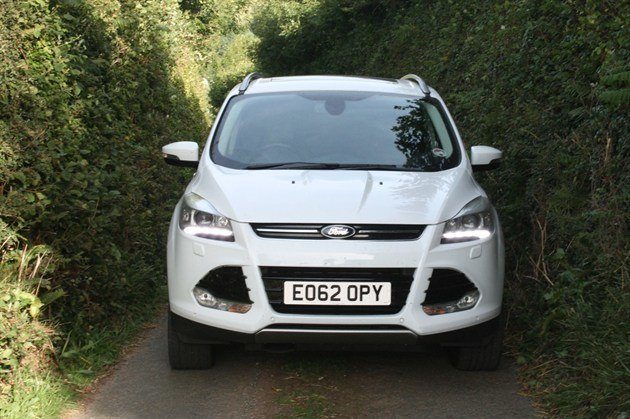
Devon’s narrow lanes proved to be a tight squeeze for the Kuga
As you can see, there's with little room to spare for a large SUV like the Kuga. However, despite the lack of space, the Kuga coped with the narrow and twisty roads, thanks to its excellent road handling and responsive steering.
The 2.0-litre Duratorq TDCi had little trouble in munching the miles and the combination of the PowerShift automatic gearbox meant that driving in hill conditions is easy. In fact, I’ve grown quite fond of the six-speed ‘box and it really does make life a lot easier behind the wheel, with smooth and intelligent gear changes.
Obviously, driving an SUV, I felt compelled to take the Kuga off the beaten track wherever possible, starting with muddy tracks and progressing to excursions across a number of rutted fields. I also took the Kuga onto one or two beaches – where permitted – and the all-wheel drive system did everything asked of it.
The only downside at the end of the holiday was the fuel economy: it’s nowhere near Ford’s claimed 45mpg. After returning from Devon the Kuga was reporting 36mpg and I’ve edged that up 0.9 over the last few days by steering clear of the Powershift’s ‘sport’ mode; however, I’m not overly confident I’m going to get in to the mid-40s, but it’s still early so maybe it can be done.
Oh yes, and there is another problem - the Kuga’s iPod connectivity has stopped working; however, you’ll hear more about that in my next update…
The computer says 'no'
Kuga gives us the silent treatment as iPod connectivity stops working. Thankfully the DAB radio has stepped up to the challenge.
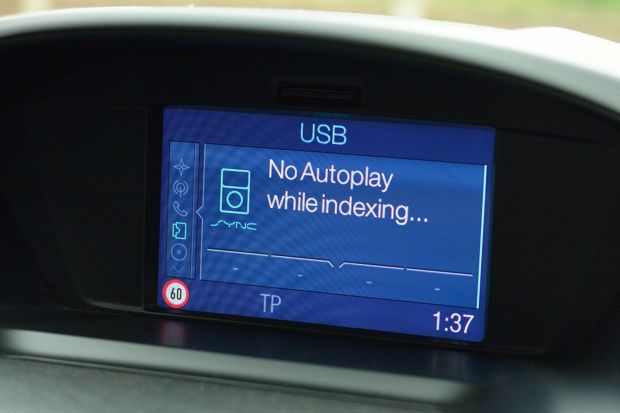
Date: 12 September 2013 | Current mileage: 1354 | Claimed economy: 45.6mpg | Actual economy: 36.6mpg
It’s been a quiet few weeks for the Ford Kuga, but not from lack of use. You see, 14 days ago the Kuga’s iPod connection stopped working and it’s been silent ever since. Things started to go wrong when I noticed a ‘clicking’ sound and then things got progressively worse, with music tracks becoming corrupted. The whole system stopped altogether two weeks ago and now it refuses to recognise any audio device. Instead, I get the perpetual message, which states “No Autoplay Whilst Indexing...”
Obviously, I’ve tried all the usual techniques to coax it back into life, including checking the connection leads, updating the iPod software, reading the owner’s manual and trying other MP3 players, but all to no avail. The iPod connection is dead and nothing I will say or do will bring it back.
Ford have been helpful throughout this episode, doing their best to remedy the issue by providing remote support. They’ve also sent me a new set of connection leads, but this didn’t fix the problem and it appears it is far more deep routed than a mere loose connection. I have now booked the Kuga in for a diagnostics session with my nearest Ford dealer and we’ll see what the men in blue have to say about it.
However, it has not all been bad, with everything else working fine. The lack of iPod connectivity has meant I’ve been using the digital radio and (cue the time warp music) listening to some CDs. Yes, CDs, remember those? The Sony audio system is rather good and the Kuga has nine speakers to boom out my choice of sounds.
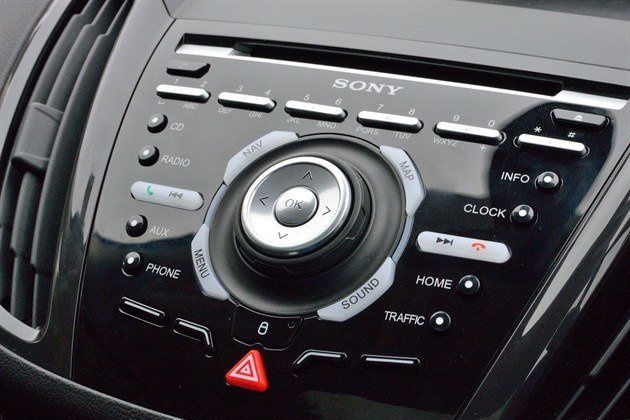
The Sony DAB Navigation pack has impressed, although the iPod connectivity has come up short with technical glitches
You can control everything from volume to station selection from your fingertips, thanks to a pair of remote audio controls, which are located on the steering wheel. Fitted as standard, the controls are easy to use and double up as inputs for the in-built (optional) sat nav system, which I’ve become increasingly familiar with these past two weeks.
Part of £750 navigation pack – which includes reversing camera, Bluetooth connection and voice control – the sat nav isn’t cheap. In fact, if you’re not fussed about Bluetooth and the rear camera, you’d be better buying a cheap, stick-on portable unit for a few hundred pounds. But, pricing aside, the sat nav is very good and has a number of useful features that help you get to your destination on time.
This was demonstrated particularly well when I took the Kuga to the Friday session of the Goodwood Revival. Not only did the system get me from Cambridge to West Sussex in a respectable two hours, it also avoided a number of nasty jams. Unlike some other in-built systems, the sat nav is clear in its directions too and provides plenty of warning about changing lanes and making turns.
The added benefit of Bluetooth also means I can get into the car and not worry about fiddling around to get it connected. My phone simply bleeps and it’s all set up. Perfect.
Ford Kuga transforms into a van
It has been a prime time for the Kuga as we’ve discovered it also transforms into a rather good van.
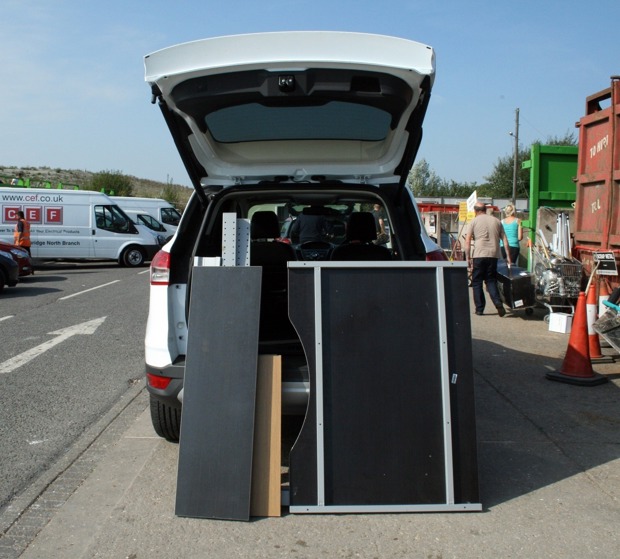
Date: 26 September 2013 | Current mileage: 1700 | Claimed economy: 45.6mpg | Actual economy: 36.1mpg
It’s been a case of cometh the hour, cometh the van for the Ford Kuga, as I’ve pressganged the SUV into service as a commercial vehicle. The decision to use the Kuga as a van came as I realised I needed to clear my flat of junk - a move I’d been putting off for months. However, after falling over a half dismantled desk one night and stubbing my toe on a collection of knackered chairs the week before, I decided enough was enough - the junk had to go.
On paper the Kuga was perfect for my load lugging needs, with a smudge over 1600 litres of space when the rear seats are down. The rear of the car also has lots of durable plastics, which soak up any bumps or scratches along the way.
Transforming the Kuga from a family friendly SUV into a burley van was a relatively simple task as all I needed to do was remove the load cover and lower the rear seats – all of which took less than two minutes. In fact, the seats were particularly impressive, with two small levers – one for each side - activating the mechanism to flatten the load space. Admittedly, it wasn’t totally flat, as you’d get most estates, but it was close enough to ensure I could load the Kuga up.
As mentioned in previous updates, my car benefits from a number of paid for options, including a powered tailgate. The system costs £350 and has a ‘hands free’ feature that allows you to open and close the tailgate by waving your foot under the rear bumper. In practice, hands free option is rather useful, but you can feel a tad daft as you stand, holding a chair, waving your foot around.
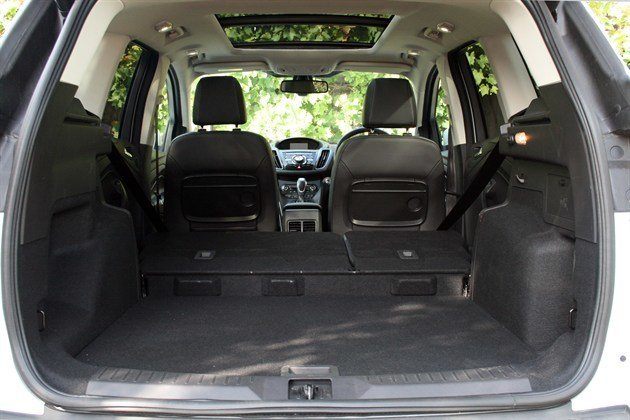
With 1604 litres of load space, the Kuga is big enough to cope with most heavy loads.
The first attempt was fruitless as I forgot to put the key fob in my pocket, which meant my neighbours stood and watched in amusement as I waved my foot around the Kuga like some injured footballer. However, with the mistake corrected, the system worked perfectly and made the process of loading the Kuga considerably easier. The powered tailgate also proves useful when loading up shopping and the like too. When your hands are not full, you can operate it by pressing a button on the key fob.
As mentioned, the Kuga’s rear plastics and carpets are extremely tough and durable. The car also has a low floor, which makes it a breeze to load it up. In one trip, the Kuga swallowed up two desks, 10 bags of rubbish and three chairs. In fact, such was its success, my neighbour persuaded me to help him shift a load of garden furniture too.
All in all, the Kuga breezed through its commercial duties, while its rear privacy glass ensuring that everything in the back was hidden from view. I found that the structure of the load floor, raised slightly by the rear seats, actually worked in my favour as it allowed me to put the heavy items at the font, and lighter items against the seats. Once all done, it was simply a case of giving it a once over with the vacuum and raising the seats. Reinstalling the load cover was easy too.
Away from its use as a van, the Kuga has covered 340 odd miles, with the usual mixture of rural and motorway runs. Sadly the fuel economy hasn’t improved, with it nudging just ahead of 36mpg – still well short of Ford’s claimed 45.6mpg. The iPod player is still refusing to work, but Ford will be taking a proper look at that next week...
Ford fixes the Kuga
After weeks of music mishaps, Ford takes the Kuga in for some much needed maintenance.
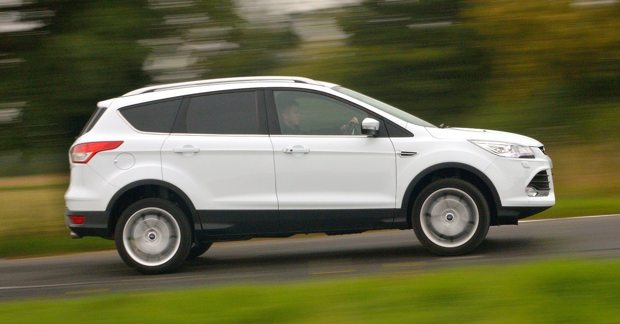
Date: 10 October 2013 | Current mileage: 2128 | Claimed economy: 45.6mpg | Actual economy: 37.2mpg
After weeks of problems with the Kuga’s Sony DAB audio system, Ford decided that enough was enough and took the car in for a maintenance check. The problems started about a month ago when the Sony system refused to recognise my iPod. This left me somewhat baffled as, being in Titanium X trim, my Kuga was supposed to feature the latest iPod functionality. It was also - at least in theory - capable of playing music and indexing all of my music and empowering me to choose what I wanted to listen to via steering wheel mounted controls. So what went wrong?
Well, first it was assumed that the USB interface was broken. You see, the music system connects to the iPod via a lead, which lives in the centre console. The fact the wire was broken sounded like a plausible explanation as not only is it fiddly to plug-in, but it also need much bending and twisting to stow away. So, Ford sent me a new lead, which arrived within a few days. Did it work? No.
Clearly it wasn’t a connection issue then. Next, I tried out a number of other iPhones, MP3 players and USB connections to rule out a fault with my music players. None of these worked either. So, following a few more calls with Ford, it was decided that the Kuga would need to go back and be examined by a professional who knew about these things.
The car went back and, roughly a week later, I had a call to say it was all fixed. The problem, it turns out, was a glitch in the software that powers the entertainment system. To remedy the fault the Ford boys updated the software and spent a few days testing it. The result was not only a working iPod connection, but also a noticeably quicker connection process. Ford assures me that all of this work is covered under warranty.
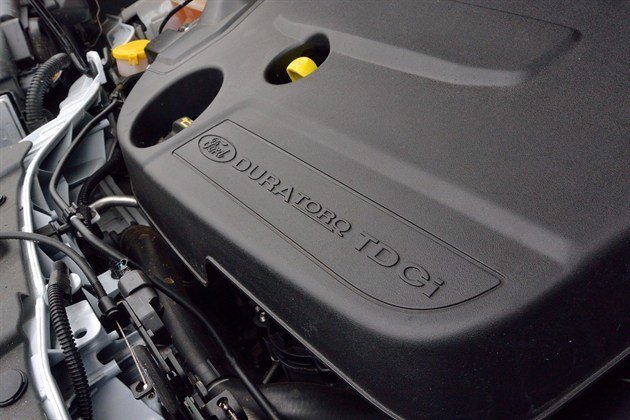
The 2.0 TDCI is an excellent engine, even if it does suffer from a bit of a drinking problem
Audio issues aside, the Kuga has been performing well in the wet and wintery weather. The 2.0-litre TDCI engine continues to impress, with its 163PS proving purposeful, with mountains of torque, with power peaking from 2000 – 3500rpm, which makes it perfect for overtaking and motoring through the mid-range.
At times it’s easy to forget you’re driving a huge 1690kg SUV and slip in to saloon driving mode, as you cut through the rush hour traffic and run along the outer lane of the motorway. In fact, the Kuga really is fast establishing itself as a real driver’s car and it’s difficult to emphasis just how effortless it is to drive on a daily basis. In the past SUVs were cumbersome and a chore to drive, but not here.
The brakes are brilliant too, with 320mm discs on the front, with 16-inch callipers, and 280mm discs at the rear. In practice these super stoppers only require a gentle motion from the pedal to bring speed down 20 or 30 per cent, which makes them perfect for high speed running. What’s more, the Kuga gets a catalogue of electric aids – ABS, brake assist, ESP with trailer stabilisation and rollover mitigation – to inspire confidence behind the wheel.
However, while the Kuga can masquerade as a saloon car behind the wheel, it cannot hide its SUV identity at the pumps. I’ve been balancing my driving with a mixture of driving styles to see how the fuel economy varies, yet it remains in the 36-37mpg range.
I’ve tried everything to reach Ford’s claimed 46.5mpg – including two weeks of frugal driving below 3500rpm, but the fuel counter refuses to budge. The 37.1mpg is the best I’ve achieved and I’m not all that confident I will ever touch the sort mid-40 numbers Ford has claimed. But there's still six weeks to go, so maybe I can get it close to 40mpg. We will wait and see.
Continental companion
The Kuga takes to the French autoroutes as we test its mettle on the continent. And the good news is that it makes the perfect long distance companion.
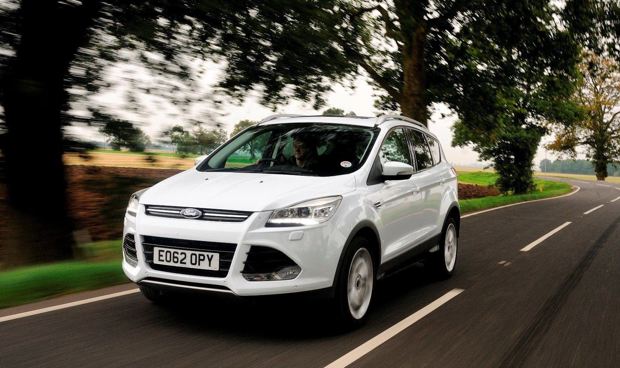
Date: 25 October 2013 | Current mileage: 2593 | Claimed economy: 45.6mpg | Actual economy: 35.8mpg
The Kuga has been racking up the miles these past few weeks, as I’ve used it to commute to work and transverse the highways of Europe. You see, after a busy few months at HJ towers, I decided to treat myself and the family to a weekend away in Paris. Obviously, the Kuga was the perfect companion for such an excursion and, without much hesitation, I booked a last minute deal, loaded up the car and headed for Dover with the family in tow.
As mentioned in previous updates, the Kuga has a cavernous interior and had little trouble accommodating everyone as we clocked up the miles down to the south of England. The leather seats and the full-length glass panorama roof was also met with praise from my passengers, who gave the Kuga’s cabin 10 out of 10 for space and comfort.
Other benefits of the Kuga on long runs include its a pair of seatback tray tables in the rear. The little tables are perfect for kids and are made of robust plastic, so there’s no danger of them snapping. They also feature a flat table – perfect for toys of games – and a little cup holder, which can carry a small bottle of water or juice.
The journey to France was pretty uneventful, although I had to reconfigure the sat nav system to French roads, which took less than a minute. However, once informed of its new country, the sat nav had little trouble finding its way to Paris, while its traffic alerts kept the Kuga away from any congestion.
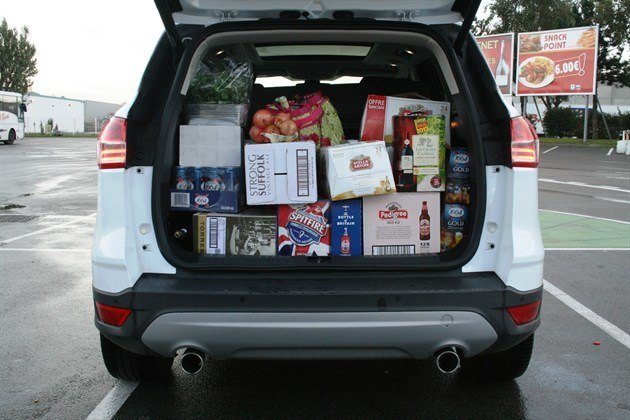
The Kuga's large boot was more than big enough to hold our 'vital' weekend supplies
As with any trip to France, an obligatory trip to the supermarket in Calais was in order and the Kuga had no trouble carrying all of our weekend supplies. In previous updates, I’ve worded caution in relation to the Kuga’s boot size, but over the last few months I’ve found its 406 litres of load space to be more than sufficient for my everyday needs. The only time it has struggled was when I loaded it up my girlfriend’s suitcases on a holiday to Devon, but that may say more about her luggage habits than the car’s carrying capacity.
My trip, with a fully laden car, also gave me a number of opportunities to try Ford’s active park assist system, which can automatically steer the vehicle into a parallel parking space. The system works by using ultrasonic sensors on the bumpers to steer the car into the space.
To operate, you thumb a button on the console and drive slowly along a line of parked cars until the sensors find a suitable space. Once detected, it will ask the driver to put the car into reverse, where it will take control of the wheel and steer the car, leaving the driver to operate the throttle and brake.
In practice, for the first few runs at least, it feels most unnatural to be sat behind the wheel of a car that’s steering itself. I hold no shame in admitting that I aborted the first two attempts and parked the car manually after losing my nerve. However, I eventually succumbed and allowed the system to complete its work and automatically park the car. Indeed, I’m now very attached to the system and find it comes into its own after a long journey, when you’re not really in the mood for the rigmarole of parallel parking.
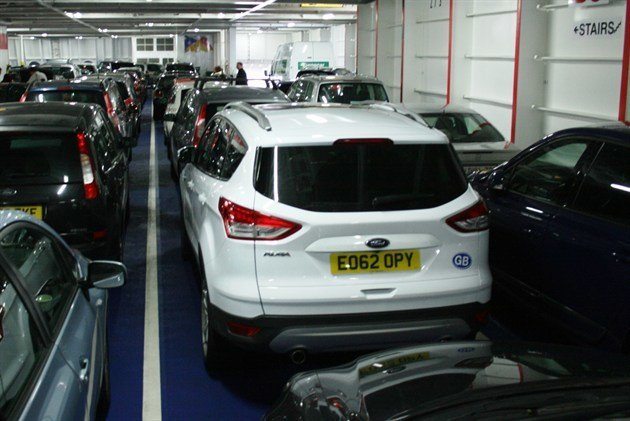
The Kuga’s Frozen White paint makes it easy to find in any car park or boat deck
Like all good things in the world, the active parking system is an optional extra – part of the convenience pack with powered fold door mirrors – and costs £550, but is well worth the money in my view, especially if you lack the confidence to parallel park a large SUV.
The Ford also continued to impress on the road, with the French mix of autoroutes and county lanes proving most enjoyable. The Kuga really is a driver’s SUV and mirrors a number of similarities to the S-MAX, in the sense it boasts superb handling and impressive amounts of torque. In fact, for its size, I’d place it only second to the Audi Q3 in regards to handling – it really is that good.
On the down side though, the trip to France proved again that the Kuga's claimed fuel economy of 45mpg is not reflective to real life motoring. On the contrary, the onboard computer is reading 35mpg, which made the weekend away a bit more expensive than planned. However, two months in to my loan with the large Ford, the fuel consumption is the only true grumble I have.
Ford Kuga or Audi Q3?
I compare Ford’s range-topping SUV with same of the competition. How does it fare against the sleek and slender Audi Q3?

Date: 8 November 2013 | Current mileage: 3001 | Claimed economy: 45.6mpg | Actual economy: 36.3mpg
Regular readers of Our Cars will know that the Ford Kuga has won many plaudits in the Powell household. Big, comfortable and hugely practical, the Ford has ticked all of the SUV boxes over the last few months, but how does it compare to the competition?
Priced at £29,800, the Kuga Titanium X goes up against some pretty stiff competition, with the likes of the Audi Q3, Hyundai Santa Fe and Volvo XC60 all baying at its heels. I’d be lying if I said I hadn’t been casting an envious eye over the other SUVs.
As luck would have it, I was involved with an Audi test recently and given a Q3 2.0 TDI Quattro to drive. What better way to compare the Kuga's mettle than perform a twin test? Some car snobs may argue that contrasting an Audi with a Ford is a major no no, but in my book, cars in the same price range are fare game.
Like the Kuga, the Q3 is powered by a 2.0-litre diesel, but the Audi engine has 177PS compared to the Ford’s 163PS. The Q3 is also cleaner, with 156g/km of CO2 compared to the Ford’s 162g/km. However, claimed fuel consumption is the same, with both cars reporting 47.9mpg.
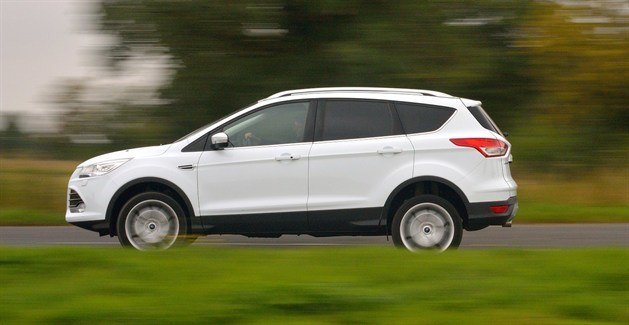
Ford Kuga beats the Audi Q3 on size and spec, with glass roof and heated seats included as standard
The first notable difference between the two can be found in the boot; the Ford is considerably larger, with 406 litres of storage compared to the Audi’s 356-litre area. Push the seats down and that advantage extends, with the Kuga swallowing up 1603 litres compared to the Audi's 1365 litres. That's a lot, when you consider that the Kuga measures three inches longer than the Q3.
It’s also worth noting that Ford packs a lot more kit into its car, with rear tables, heated seats and full length panoramic roof all included as standard. In comparison, the Audi gets very little and I have to admit that the Q3 - in S Line trim - felt rather bare, with just dual climate control and a CD player on offer. However, in Audi’s defence, the Q3’s interior is notably more refined, with better quality trims and finishes throughout the cabin.
Venture onto the road and the Audi Q3 starts to show its pedigree, with its engine being quicker and quieter than the 2.0-litre unit in the Ford. Dump the throttle and the Q3 will clear 0-62mph in 8.2 seconds, which is a country mile ahead of the Kuga’s 10.4 seconds. The Audi also feels a lot tighter in the corners, with virtually no body roll or understeer to report. That’s not to say the Kuga is cumbersome - it isn’t – but the Audi just feels a lot more agile.
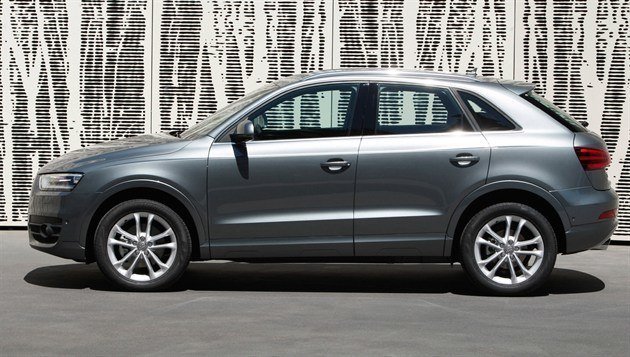
Performance and road handling are firmly in the Q3’s favour with the 0-62mph dash taking just 8.2 seconds
However, for as much as it is better to drive, the Q3 can’t compete with the Kuga on interior comforts and the Ford is cavernous in comparison. In fact, the Kuga will easily transport three adults in the back; try and replicate that in the Audi and you’ll get all manner of complaints as your passengers squeeze and wheeze their way into the smaller seats.
So, which car is best? Performance or practicality? Well, that’s a tricky one. But on price, the Kuga's £29,800 undercuts theQ3 2.0 TDI Quattro by £1400, with its price starting at £31,210. The Kuga also defeats the Audi on value for money, thanks to Ford's generous amounts of standard kit.
Make no mistake, the Q3 is a fine car, but for me it doesn’t quite tick the boxes when it comes to fulfilling the role of a large family car. To compete, I think you’d have to look at getting a Q5, but even then you’d be reaching the £40,000 barrier to match the equipment and performance of the Ford. I’m just not sure I’d be able to justify the extra £10,000.
A fond farewell for our Ford Kuga
After three months and more than 3000 miles, it’s time to say goodbye to our Ford Kuga. It's become a firm favourite in the Powell household and we’re sorry to say goodbye.
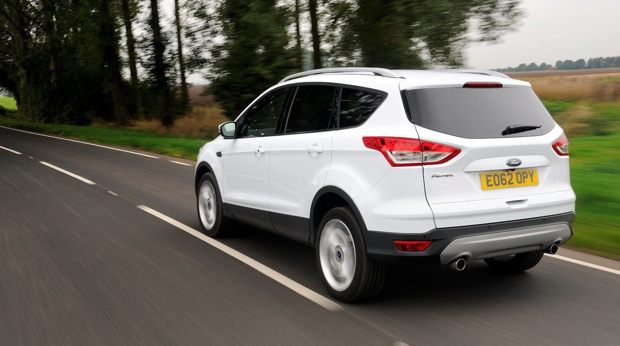
Date: 22 November 2013 | Current mileage: 3453 | Claimed economy: 45.6mpg | Actual economy: 36.7mpg
It’s difficult to believe that three months has passed since I took delivery of the Kuga, yet here we are, with Ford's collection driver knocking at my door wanting the keys to take Ford’s likeable but capable SUV back to its Essex home. Yes, it might have suffered some technical glitches along the way, and no it doesn’t give anywhere near its claimed 45.6mpg, but the Kuga has become won some key fans in the Powell household and I’ll be sorry to see it leave.
The biggest benefit of the Ford Kuga is its interior space and versatility; during its three month stay I have taken it on holiday, used it for a jaunt to France and also converted it into a van. On each time of asking, the Ford has fulfilled its duties and given me the impression that this is a car I could quite happily live with for a few years.
During its time on the Powell fleet the Kuga has clocked up 3500 miles and I have few complaints. The cabin is extremely comfortable and a huge step forward in terms of refinement over the previous generation of Kuga, with one of the best layouts in its class. Both the front and rear passengers get acres of space and there are some nice touches, with air con, audible text messaging and keyless start all included as standard.
Being a Titanium X model, the Kuga has all manner of bells and whistles – leather seats, TFT display screen, padded centre console – but none comes close to winning the praise I have for its panoramic opening roof. In short, the glass roof is fantastic and the powered opening was a welcome addition on hot summer evenings. It brightens the whole of the cabin and provides a nice, airy feel to the interior.
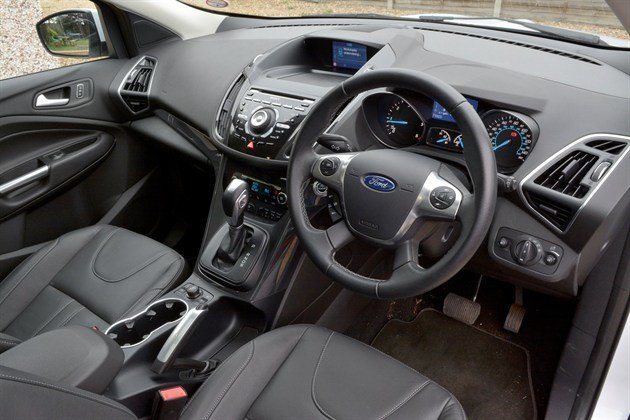
The Mk2 Kuga is a big step up from the previous generation, with a well-designed dashboard and spacious interior
My test car also had a number of extras fitted, but to be honest I’d only recommend paying for the Appearance pack – with roof rails and privacy glass – along with the Convenience Pack, which has folding door mirrors and active park assist. I was initially a bit sceptical about giving the power of parallel parking to the car’s computer, but I quickly became hooked to it. It’s no secret that large SUVs are not the easiest things to wedge into tight spaces, but the automatic system took all of the pain out of squeezing the Kuga into the smallest of spots.
The Kuga also impressed on the road, thanks to responsive steering, a smooth PowerShift automatic box and a superb 2.0-litre diesel engine. While it may be true that some rivals offer sharper handling and more power, the Kuga is a rewarding and enjoyable experience. Be it on motorway or country road, the Ford feels composed and refined at all times.
The diesel engine’s 163PS was more than enough for my SUV needs and I never found it wanting, regardless of terrain or hills. It’s a quiet unit too and there were a number of occasions that my passengers thought it was a petrol, such was its refined nature.
I’d be lying if I said I wasn’t a little disappointed that the 2.0 TDCI only achieved 36.7mpg – a long way short of Ford’s claimed 45.6mpg – but this reflects what our Real MPG reports say, with even the most frugal of drivers recording 38.9mpg. Clearly I am not the only one who found this Ford to be a tad thirsty.
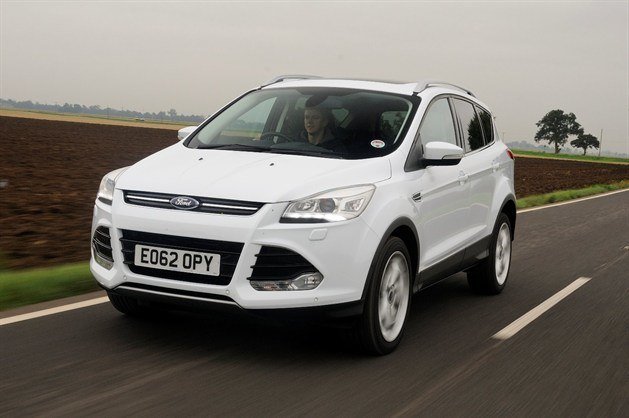
Kuga impressed us with its road handling and quiet but punchy 2.0 TDCI
The media system also stuttered along and finally gave up the ghost after refusing to identify my iPod. To Ford’s credit, it fixed the problem with a software update, but I have to say I was a little disappointed that a new car would suffer such problems in the first place.
Yet, these grumbles aside, I was impressed with the Kuga. It handles great on the road and holds its own off the tarmac, as my jaunt across a few Devonshire beaches proved. Ford really have done an excellent job of combining the practicalities of a large SUV with the mannerisms of a standard hatchback.
Would I buy a Ford Kuga? Yes, but I’d only go for the Titanium X if you really, really want a glass roof, otherwise I’d recommend downgrading to the Titanium. Not only does the lower trim save you £2750, but it has almost everything else you’d ever need. Just put £550 aside for the convenience pack, you won’t regret it.

